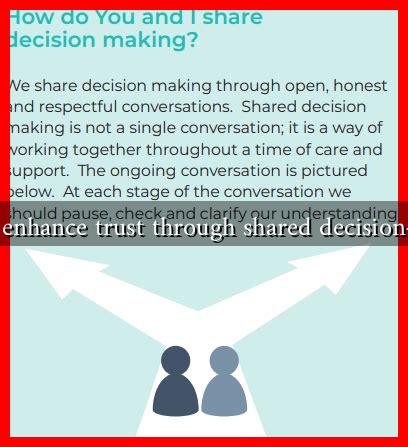-
Table of Contents
- How to Enhance Trust Through Shared Decision-Making
- Understanding Shared Decision-Making
- The Importance of Trust in Decision-Making
- Benefits of Shared Decision-Making
- Strategies to Enhance Trust Through Shared Decision-Making
- 1. Foster Open Communication
- 2. Provide Comprehensive Information
- 3. Respect Individual Preferences
- 4. Build a Collaborative Environment
- Case Studies: Successful Implementation of Shared Decision-Making
- Conclusion
How to Enhance Trust Through Shared Decision-Making
In today’s fast-paced world, trust is a cornerstone of effective relationships, whether in healthcare, business, or personal interactions. One of the most effective ways to build and enhance trust is through shared decision-making (SDM). This collaborative approach not only empowers individuals but also fosters a sense of ownership and accountability. In this article, we will explore the principles of shared decision-making, its benefits, and practical strategies to implement it effectively.
Understanding Shared Decision-Making
Shared decision-making is a collaborative process that involves patients and healthcare providers (or stakeholders in other contexts) working together to make informed decisions. This approach contrasts with traditional models where decisions are made unilaterally by the provider or leader. SDM emphasizes the importance of patient or stakeholder preferences, values, and circumstances.
The Importance of Trust in Decision-Making
Trust is essential in any decision-making process. When individuals feel trusted, they are more likely to engage openly and honestly. This engagement leads to better outcomes, as decisions are made based on comprehensive information and mutual understanding. According to a study published in the *Journal of Health Communication*, patients who participate in shared decision-making report higher satisfaction and adherence to treatment plans.
Benefits of Shared Decision-Making
Implementing shared decision-making can yield numerous benefits, including:
- Improved Patient Satisfaction: Patients who are involved in their care decisions tend to be more satisfied with their treatment.
- Better Health Outcomes: Research indicates that shared decision-making can lead to improved health outcomes, as patients are more likely to follow through with treatment plans they helped create.
- Enhanced Communication: SDM fosters open dialogue, allowing for better understanding and clarification of complex information.
- Increased Trust: When patients feel their opinions are valued, trust in the provider increases, leading to a stronger therapeutic alliance.
Strategies to Enhance Trust Through Shared Decision-Making
To effectively implement shared decision-making and enhance trust, consider the following strategies:
1. Foster Open Communication
Encourage an environment where individuals feel comfortable expressing their thoughts and concerns. This can be achieved through:
- Active listening techniques
- Non-verbal cues that show engagement
- Regular feedback sessions
2. Provide Comprehensive Information
Ensure that all parties have access to relevant information. This includes:
- Clear explanations of options and potential outcomes
- Visual aids or decision aids to simplify complex information
- Resources for further reading, such as Health.gov.au
3. Respect Individual Preferences
Recognize that each individual has unique values and preferences. Tailor the decision-making process to accommodate these differences by:
- Asking open-ended questions to understand preferences
- Incorporating cultural considerations into discussions
- Allowing time for reflection before making decisions
4. Build a Collaborative Environment
Encourage teamwork and collaboration among all stakeholders. This can be achieved through:
- Regular team meetings to discuss shared goals
- Encouraging input from all team members
- Recognizing and celebrating collaborative successes
Case Studies: Successful Implementation of Shared Decision-Making
Several organizations have successfully implemented shared decision-making, leading to enhanced trust and improved outcomes. For instance:
- The Cleveland Clinic: This healthcare institution has integrated SDM into its practice, resulting in higher patient satisfaction scores and better adherence to treatment plans.
- Geisinger Health System: By utilizing decision aids and engaging patients in their care, Geisinger has reported improved health outcomes and reduced costs.
Conclusion
Enhancing trust through shared decision-making is not just a theoretical concept; it is a practical approach that can lead to significant improvements in various fields. By fostering open communication, providing comprehensive information, respecting individual preferences, and building a collaborative environment, organizations can create a culture of trust and engagement. As we move towards a more patient-centered and collaborative future, embracing shared decision-making will be essential for achieving better outcomes and stronger relationships.

